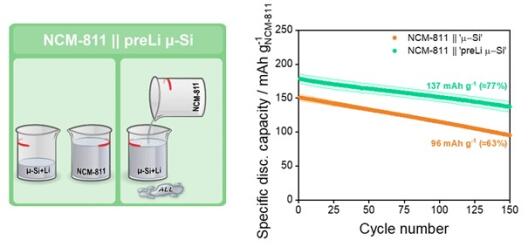Practical Applicability of Pre-Lithiation Process “Lithium Metal Thermal Evaporation” Examined
An innovative pre-lithiation process for silicon (Si) anodes developed by MEET Battery Research Center at the University of Münster is based on the thermal evaporation of lithium metal in pure Si thin film anodes. Rather than dealing with the challenges of inevitable volume expansion occurring during operation of lithium-ion batteries (LIB) with Si anode, pre-lithiation is aimed at compensating for active lithium losses before implementation in the LIB-cell. In a subsequent study, the scientists have now systematically investigated the practical applicability of the innovative process when using composite electrodes.

Detailed Analysis of Lithium Metal and Full Cells with Pre-Lithiated Si Electrode
The pre-lithiated Si-based negative electrodes were evaluated in both Li metal cells and a full-cell setup with lithium nickel cobalt manganese oxide (LiNi0.8Co0.1Mn0.1O2, NCM-811) as cathode material in two-electrode and three-electrode configurations. "This is necessary to evaluate practical relevance as well as for a more comprehensive electrochemical analysis", says Egy Adhitama, doctoral student at the International Graduate School for Battery Chemistry, Characterization, Analysis, Recycling and Application (BACCARA) and at MEET Battery Research Center of the University of Münster. The use of micron-sized powder-based Si-based anodes in combination with Ni-rich NCM-811 as cathode material is of great importance as these materials have both the potential to boost the energy density of LIBs to meet increasing demands for high-energy applications such as electro-mobility. The results show that NCM-811 || pre-lithiated Si full-cells can attain a higher initial discharge capacity with better capacity retention than cells without pre-lithiation. Furthermore, this study also deeply discusses significant consequences of negative to positive electrode capacity balancing (N:P ratio) with regard to pre-lithiation on the performance of full-cells in terms of depth of lithiation of Si, cell life time and energy density.
MEET scientist Dr Aurora Gomez-Martin explains: "The phenomena discussed in our study shall provide guidance to the research in using the thermal evaporation of Li metal as a pre-lithiation technique on Si anodes. Our long-term goal is to reach the point when the optimum cell system comprising Si as an anode can be applied without sacrificing both energy density and stability."
Complete Study Open Access
The detailed results of their study have been published by Egy Adhitama, International Graduate School BACCARA and MEET Battery Research Center, Marlena Maria Bela, Feleke Demelash, Dr Marian Stan, Dr Aurora Gomez-Martin and Dr Tobias Placke, MEET Battery Research Center, and Prof Dr Martin Winter, MEET Battery Research Center as well as Helmholtz Institute Münster of Forschungszentrum Jülich, in the scientific journal "Advanced Energy Materials".

